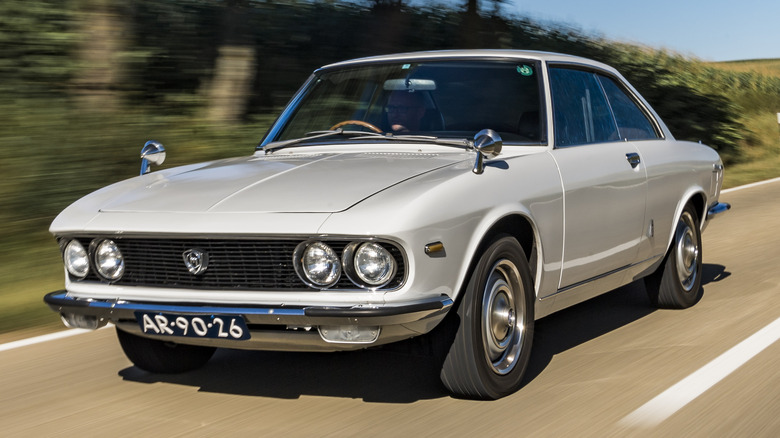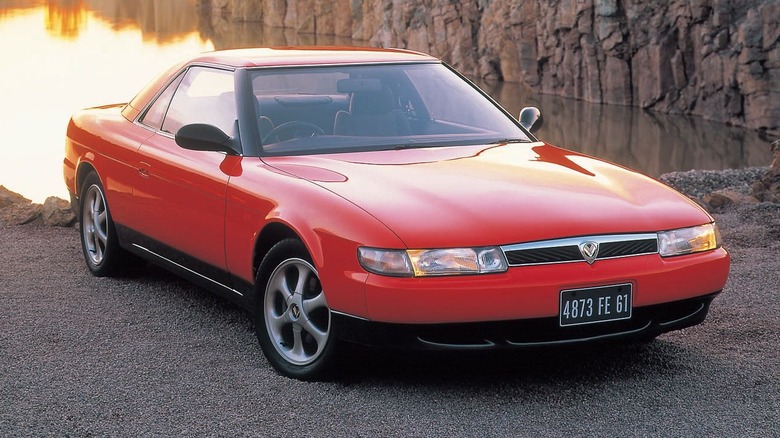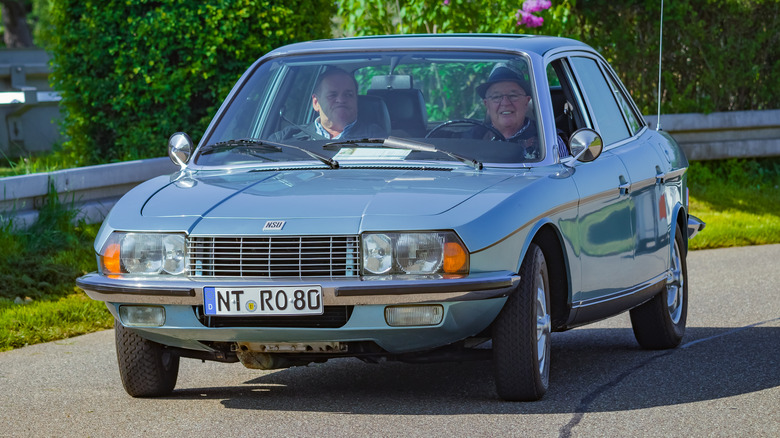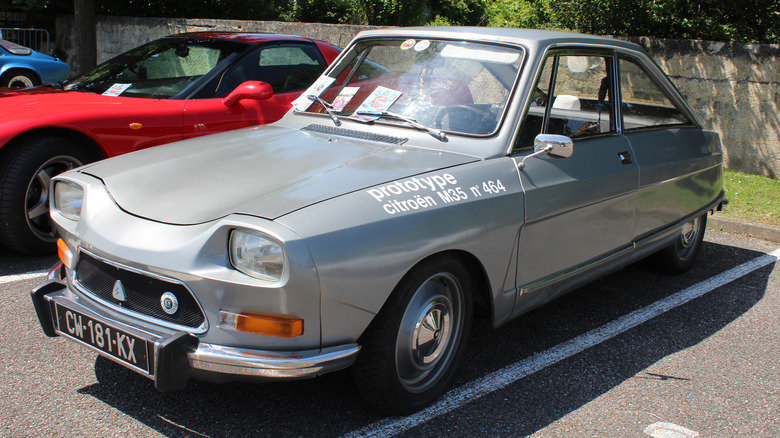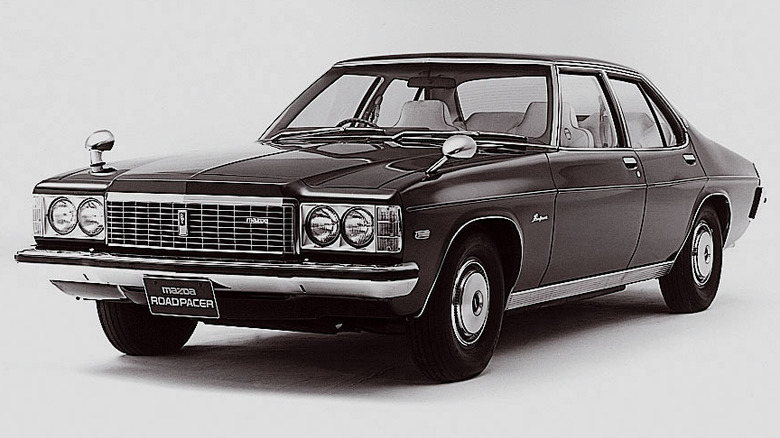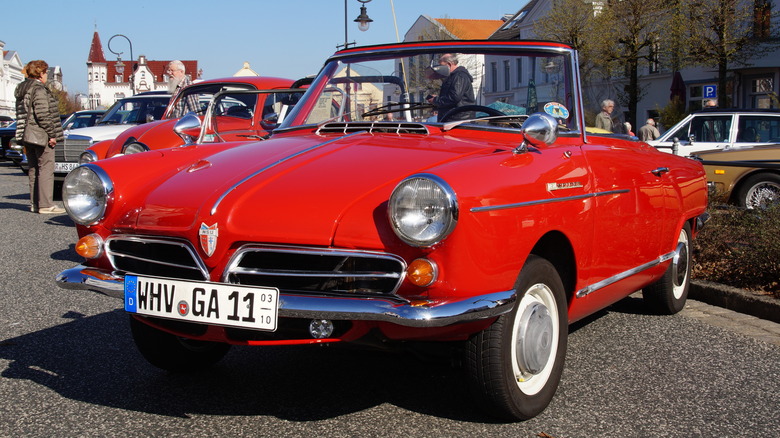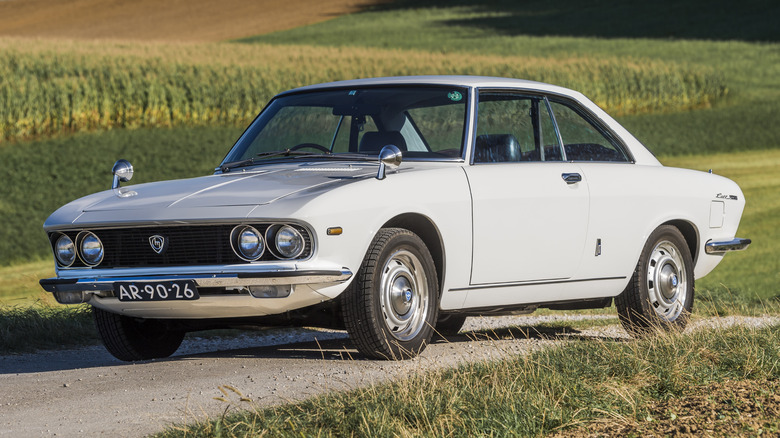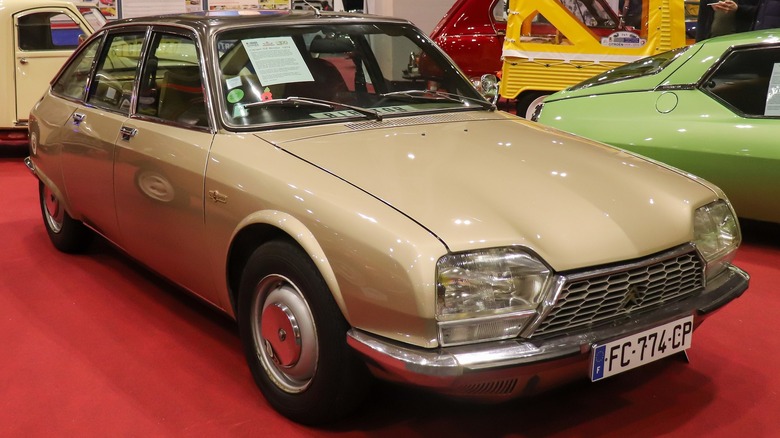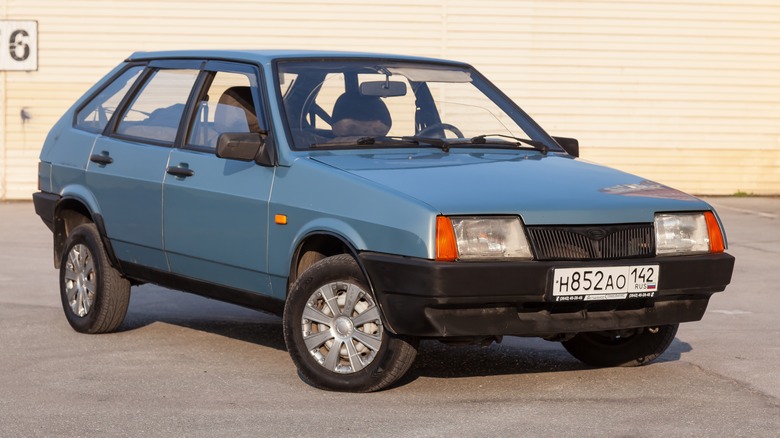8 Rotary-Powered Cars That We'd Be Shocked To See On The Road
Designed and championed by self-taught engineer Felix Wankel, the rotary engine is now most closely associated with Japanese automaker Mazda. Many of the greatest Mazdas ever made, including the RX-7 and Le Mans-winning 787B, have featured rotary engines. However, Mazda is just one of several major automakers that have experimented with rotary engines over the years. The first automaker to bring the technology to market was the now-defunct NSU — ironically, it would be the rotary engine's durability and efficiency issues that saw its developer fall into bankruptcy.
For every iconic rotary-engined car, there are many more innovative models that have been largely forgotten over the decades. In many cases, a small enthusiast club exists to preserve what's left of these unusual cars, keeping the few survivors on the road and engineering solutions to fix their quirks and weaknesses. Outside of those niche circles though, it's very unlikely that the average car spotter will ever be able to see one on the road. Here are eight particularly notable models that we think deserve to be remembered, even if they're now vanishingly rare.
Eunos Cosmo
The original Mazda Cosmo Sport of the '60s was the world's first dual-rotary-engine sports car, and it has become highly sought after among collectors. However, later models in the Cosmo line have remained mostly under the radar. The last car to bear the name was marketed under Mazda's luxury sub-brand, Eunos, and debuted in 1990. Much like the original Cosmo Sport, the Eunos Cosmo was a pioneer, being the first production car with a triple-rotor engine. To date, it remains the only roadgoing car to feature such an engine.
As well as its unique powertrain, the Eunos Cosmo also featured technological innovations including the world's first built-in GPS system. Marketed only in Japan, the Eunos Cosmo was designed to be both more luxurious and more powerful than any other Mazda vehicle before it. Its power output was limited by the Japanese automakers' unwritten agreement so, like all of its peers, it was officially rated at 276 horsepower. In reality, it's thought to have been considerably more powerful, with its true output somewhere north of 300 horsepower.
Despite being considered one of the most advanced Japanese cars of its day, the Eunos Cosmo never sold in high numbers, with less than 9,000 examples produced over its production run. While Mazda's other rotary-engined icons are still a common sight across car shows and events, the Eunos Cosmo remains an extremely rare sight outside of Japan.
NSU Ro80
Unveiled in 1967, the NSU Ro80 was hailed by automotive journalists as a truly groundbreaking car. It was awarded the prestigious "Car of the Year" award, being praised both for its aerodynamic styling and for its innovative engine. Unfortunately, the first buyers to get their hands on this most cutting-edge of cars soon found that it didn't quite live up to the hype. It was indeed very smooth to drive, and featured all the latest German technology wrapped up in an aesthetically pleasing package. But, it suffered from one fatal flaw: its engine kept breaking.
NSU offered a generous warranty for the era to ease buyers' fears about owning a car with such a radical engine, but it was this warranty that proved to be its downfall. Many cars reportedly underwent multiple engine replacements under warranty, and were barely able to reach 15,000 miles on average. The cost of repairs, coupled with lower sales figures thanks to the bad publicity, left NSU bankrupt and forced to merge with Audi/VW. Less than a decade later, and with Ro80 sales still painfully low, the NSU brand was axed altogether.
Despite its flaws, the forward-thinking nature of the Ro80 means that it has retained a small but dedicated fanbase over the years. Later revisions to the engine, alongside upgraded components for earlier models, fixed many of the durability problems. So any surviving examples of the car will be generally a lot more reliable, even if few are still around.
Citroën M35
The NSU-developed rotary engine caused such a stir in the European automotive industry that a number of other manufacturers signed agreements with the German marque to produce their own versions of the design. One such automaker was Citroën, which first partnered with NSU in 1967 to mass-produce rotary engines. After the disaster of the Ro80, NSU was forcibly merged with Audi in 1969, but Citroën decided to carry on its rotary research independently. To test the real-world viability of the engine, it built a limited run of 267 prototype cars badged as the M35.
The cars were never meant to be kept by customers. Instead, they were leased for a set period to certain loyal buyers, and would be reclaimed and pored over by researchers after the lease ended. However, a few examples were never returned, mostly lying forgotten about in French barns until their discovery decades later. It's not known exactly how many of them survive today.
The car was based on the Ami 8 coupe, with construction outsourced to Heuliez, a French coachbuilder. It was fitted with a single-rotor engine that produced around 50 horsepower. Despite suffering from the same durability problems that rotaries are now notorious for, the engine was praised for its smoothness and high-revving nature, with Citroën forced to fit an alarm to prevent drivers accidentally overstepping its 7,000 rpm redline. Its success encouraged Citroën to continue rotary development, albeit on a small scale.
Mazda Roadpacer AP
While European automakers mostly phased out their development of inefficient rotary engines in the wake of the '70s oil crisis, Mazda did exactly the opposite. Despite the inherent disadvantages in fuel economy, the Japanese automaker decided to continue rotary engine development, implanting them in a wider range of cars than before. One of the most unusual was the Roadpacer AP, which was built to compete with other large Japanese domestic cars like the long-running Toyota Century and Nissan President.
Unlike those cars, however, the Roadpacer was a badge-engineered import that had been merely fitted with a rotary engine. The import in question was the Holden Premier, which in its native Australia would have been fitted with a GM V8 engine. Replacing that engine with a tiny 13B rotary resulted in a car much more sluggish than the competition, as well as much less efficient. Quite ironic considering the "AP" in the name stood for "Anti-Pollution."
The car packed a number of innovative tech features, including automatic central locking and a dictation machine, but it wasn't enough to convince buyers. Between 1975 and 1977, Mazda sold just 800 examples of the Roadpacer, and most were bought for government use, and crushed after their years of service. A handful survive today in Japan, but it's not known if any examples have been exported elsewhere in the decades since production ended. The Roadpacer AP remains the only GM car to have featured a rotary engine.
NSU Spider
The first production car to feature a rotary engine was the NSU Spider, which debuted in 1963 in Europe and the following year in North America. It was this initial sporty offering that enticed so many other manufacturers to sign rotary licensing deals with NSU: The car was smooth, quiet, and refined, and garnered positive reviews from the motoring press. It was billed by both journalists and NSU as the "car of the future," with a revolutionary engine that would soon be everywhere.
However, much like the Ro80 that followed it, the Spider was plagued with reliability issues for its entire production span. Its initial billing as a radically innovative car drew buyer interest, but that interest quickly faded when numerous reports surfaced of engines failing after just a few thousand miles of driving. The car was also comparatively expensive, and by the time it was axed to make way for the Ro80, just 2,375 examples had been sold.
The production Spider, with its single-rotor engine, also wasn't quite as fast as some initial reports had made it seem. It was more potent at high revs, but its low-end torque was severely lacking, and so required drivers to alter their driving style to keep pace on the road. A competition-spec Spider with a more powerful engine racked up national hillclimb and rally championships at home in Germany, but the added power still didn't solve the engine's biggest flaw — its unreliability.
Mazda Luce R130
After its initial success with the Cosmo Sport, Mazda followed up its seminal sports car with the Luce R130. It was oriented more toward grand touring than the Cosmo, with room for four occupants and their luggage. Its design resembles many Italian GTs of the same era, and that's no accident — the Luce's bodywork was styled by a young Giorgetto Giugiaro. In fact, even the name "Luce" is derived from the Italian for "light."
Despite its head-turning European looks and respectable performance (its sub-nine-second 0-60 mph time and 119 mph top speed were competitive for the era), the Luce was never sold outside of Japan. Only 976 examples were produced between 1969 and 1972, but it's thought that around 200 of those survive today. That makes it far from the rarest car here, even if it's still thoroughly obscure by most standards. Over the decades, a number of examples found their way out of Japan, ending up everywhere from Australia to Canada. However, seeing one in person will likely involve either knowing an owner, or getting lucky and catching one of the Mazda heritage fleet's rare outings with the car.
Citroën GS Birotor
After its initial experimental run with the M35 prototype, Citroën decided to try manufacturing a rotary car on a slightly larger scale. However, Citroën was no Mazda — it wasn't going to commit to staking its future on the rotary, at least not yet. The plan was for a larger selection of models to be launched with a rotary engine later down the line, but to test the water, the mid-range GS was chosen to be the first with the new powerplant.
The GS Birotor was launched in 1973 as the most technologically advanced model in the GS line. The timing couldn't have been worse: The turmoil caused by the oil crisis meant that buyers were rapidly moving away from inefficient vehicles in favor of smaller, cheaper cars. The GS Birotor was the opposite, being both inefficient and expensive to maintain, thanks to its unreliability.
Citroën's finances were looking dire by this point, and as the automaker looked to cut costs, its rotary program was among the first to go. The decision was made that buying back and destroying the 847 cars that had already been sold would be more cost-effective than supplying parts for them as they got older. Most Birotor owners took them up on the offer. However, it's thought that a little over 200 examples survived, with at least one example confirmed to be present in America.
[Featured image by Vauxford via Wikimedia Commons | Cropped and scaled | CC BY-SA 4.0]
VAZ-2109
Years after most European automakers gave up on the rotary engine, it continued to be developed in the Soviet Union. Rather than purchase a license from NSU to produce the Wankel engine found in the likes of the Spider and Ro80, Soviet researchers chose to create their own design, based on Mazda's Wankel rotary. Unfortunately, early prototypes suffered from many of the same flaws as the NSU: unreliability, a short lifespan, and inefficiency.
Nonetheless, the first Soviet rotary engine car entered production in 1982, reserved for KGB and government use. Built by AvtoVAZ, the VAZ-21079 continued to be built until 2000. However, despite being available for officials for a decade, it would take until the 1990s for the rotary to be produced for civilian cars. One of the first publicly available cars to receive the rotary was the VAZ-2109. It was reasonably fast by Russian domestic car standards, with a 0-62 mph time in the eight-second range and a top speed of 124 mph.
Like so many European cars before it, the rotary engine's popularity in Russia was limited by its unreliability. Given its rarity, parts were also more expensive and difficult to source. Production and development work was phased out in the early 2000s, but there still reportedly remains a small club of rotary enthusiasts in Russia who keep surviving examples on the road.
